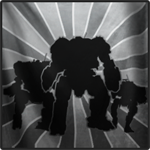Why does a 40-ton mech and a 30-ton mech, with equal-weight JumpJets end up with MORE thrust on the heavier mech, than on the lighter one? Especially if the JumpJet descriptions themselves say that the Class V JumpJets are rated to be stronger than Class IV JumpJets?
And to throw more oddities into the fire, it seems that a lower-gravity world like the HPG Manifold's has no effect on jump heights and acceleration, despite affecting gravitational pull after jumping. This bugs my inner physics geek. Right now, a single JumpJet seems to have little improvement in performance over having many JumpJets, despite all physics saying otherwise.
Why can this not be normalised? HOW can we normalise it? Let's take a look.
Let's assume that the JumpJets are from the same manufacturer, and of the same make; and therefore the same amount of thrust within the same class.
Situation 1: Real Physics
To accelerate a 30-ton mech under standard gravity (1.00 standard Earth gravity, or -9.8m/s/s ~= -10.0m/s/s) upwards, we would need to cancel out the force of gravity and then exceed it to provide vertical thrust. Let us assume that a single JumpJet is capable of doing so, as it could now.
This means that a single JJ is capable of producing:
30,000 * 11N of force, or 330kN thrust! For a real-life comparison, a single Boeing 747-400's engine (Rolls-Royce RB211) is capable of producing only 270kN thrust under maximum power. That tiny, little half-ton thruster is probably powered by antimatter, for it to produce so much power! Assuming, of course, that the amount of force applied to the mech's internal structure would not break it to begin with.
Even adding a single JumpJet on top of this would increase the vertical thrust output to 660kN, which is sufficient to propel a 30 ton mech at 12m/s/s upwards. This is akin to launching a light mech over the caldera of Terra Therma in a single boost, given the burn durations currently in game.
So clearly, this solution will not work. If a single JJ is strong enough to lift a mech off the ground, two JJs would be enough to make it fly. Clearly, this solution is far too strong.
Situation 2: Cancelling gravity
The lazy solution to this problem would be to assume that gravity magically vanishes with the aid of some anti-gravity wizardry the moment you flip the switch on those JumpJets. Without the moderating force of gravity, this means that a single JJ pushing a 30-ton mech upwards at 1m/s/s would be producing:
30000 * 1N = 30kN
This would give linear improvement in vertical movement, giving a +1m/s/s improvement in vertical thrust per JJ. It is, however, lazy, and would neglect the whole reason for giving planets their gravitational values.
Situation 3: Real physics, with burn duration
Let's assume again that the thrust of a Class-V JJ is 330kN. This is the MAXIMUM power possible from the JJ, but our previous assumption was with infinite available power and/or fuel to the JJ. Let us therefore assume that each JJ is capable of producing 330kN * 2 seconds of thrust on a 30-ton mech, and assume gravity is zero (superposition allows us to add gravity back in) and neglect all other external forces acting on the mech.
11m/s/s * 2s = 22m/s peak velocity, starting from zero, = 11m/s average velocity * 2 sec = 22m. Given that the kinetic energy, KE, imparted on an object is equal to the force applied on an object multiplied by distance, this gives us 22m * 330kN = 6.96MJ of energy per jump jet at max capacity.
Assuming that each additional JJ stores the same amount of energy, but we do not change the total thrust generated by all the JJs, this would give us a linear increase in time spent in flight without changing acceleration amounts. While this would obviously allow mechs to 'fly', so to speak (Cicada-3F has 8 JJs, meaning it can fly for 16 seconds if this was the case!) this would relegate JJs to just being HoverJets, which is not what we are after. This is the reason why lights do not really use JJs unless there are many of them.
So, given these situations with no satisfactory solution, let's take a radical approach:
- Set all JJ classes to have the same weight.
- Each JJ class has slightly increasing amounts of overall energy stored inside them for each mech, but with a different setting of burn intensity. So Class V JJs have a 2.5-second very intense burn producing very significant thrust, while Class I JJs have a 5-second slow burn producing low, but efficient, thrust. Class I JJs will have more energy stored in them than a Class V.
- Allow all mech classes to use all JJs.
- Total burn duration is an average of all JJs on a mech, plus 0.5s per JJ. This additional +0.5 is to prevent mechs which have absurd amounts of JJs (SDR-5V, CDA-3F) from shooting up to the sky with a tap of the button. As fun as that might be, I don't think the game engine will cope if it already has trouble with hitreg on mechs travelling faster than 171kph (about 45m/s).
- Acceleration is determined by a function of the energy spent vs the total mass of the mech. Heavier mechs will hover if they use a slow-burn JJ, while a light mech may go up slowly. A very heavy mech using a very low-intensity JJ may not even fly at all!
- Maps) with higher gravity will cause JJs to work less effectively, while maps with lower gravity will cause JJs to work more effectively.
















